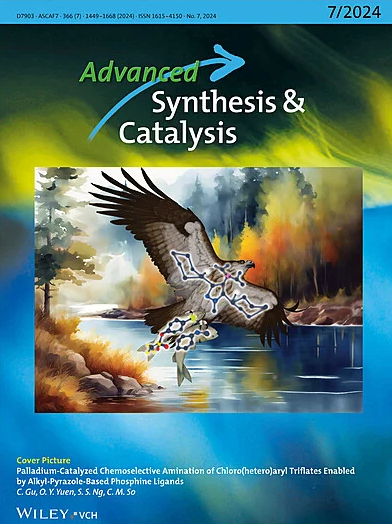碱促进[4 + 2]环加成法合成3,4-二氢喹唑啉酮
IF 4
2区 化学
Q2 CHEMISTRY, APPLIED
引用次数: 0
摘要
3,4-二氢喹唑啉-2(1H)- 1 (3,4- dhq)是在许多生物活性分子中发现的关键结构基序。虽然到目前为止已经开发了几种合成方法,但通常需要苛刻的反应条件和/或金属毒性试剂。在这项工作中,描述了一种合成3,4- dhq的一般无金属方法。该新方案依赖于原位形成的偶氮-邻醌和异氰酸酯的正式[4 + 2]环加成,从而产生各种各样的3,4- dhq,收率高达98%。本文章由计算机程序翻译,如有差异,请以英文原文为准。
![Synthesis of 3,4‐Dihydroquinazolinones via Base‐Promoted Formal [4 + 2] Cycloadditions](https://img.booksci.cn/booksciimg/2025-8/105312661061790875365.jpg)
Synthesis of 3,4‐Dihydroquinazolinones via Base‐Promoted Formal [4 + 2] Cycloadditions
3,4‐dihydroquinazolin‐2(1H)‐one (3,4‐DHQ) is a key structural motif found in many biologically active molecules. Although several synthetic methods have been developed to date, harsh reaction conditions, and/or metal toxic reagents are often required. In this work, a general, metal‐free methodology for the synthesis of 3,4‐DHQs is described. This novel protocol relies on a formal [4 + 2] cycloaddition of in situ formed aza‐ortho‐quinone methides and isocyanates leading to a wide variety of 3,4‐DHQs in yields up to 98%.
求助全文
通过发布文献求助,成功后即可免费获取论文全文。
去求助
来源期刊

Advanced Synthesis & Catalysis
化学-应用化学
CiteScore
9.40
自引率
7.40%
发文量
447
审稿时长
1.8 months
期刊介绍:
Advanced Synthesis & Catalysis (ASC) is the leading primary journal in organic, organometallic, and applied chemistry.
The high impact of ASC can be attributed to the unique focus of the journal, which publishes exciting new results from academic and industrial labs on efficient, practical, and environmentally friendly organic synthesis. While homogeneous, heterogeneous, organic, and enzyme catalysis are key technologies to achieve green synthesis, significant contributions to the same goal by synthesis design, reaction techniques, flow chemistry, and continuous processing, multiphase catalysis, green solvents, catalyst immobilization, and recycling, separation science, and process development are also featured in ASC. The Aims and Scope can be found in the Notice to Authors or on the first page of the table of contents in every issue.
 求助内容:
求助内容: 应助结果提醒方式:
应助结果提醒方式:


